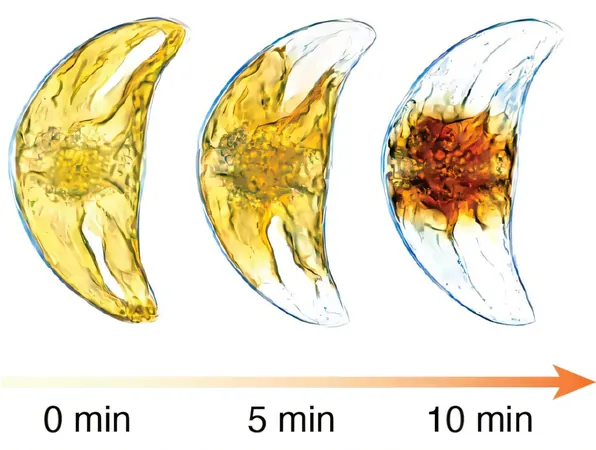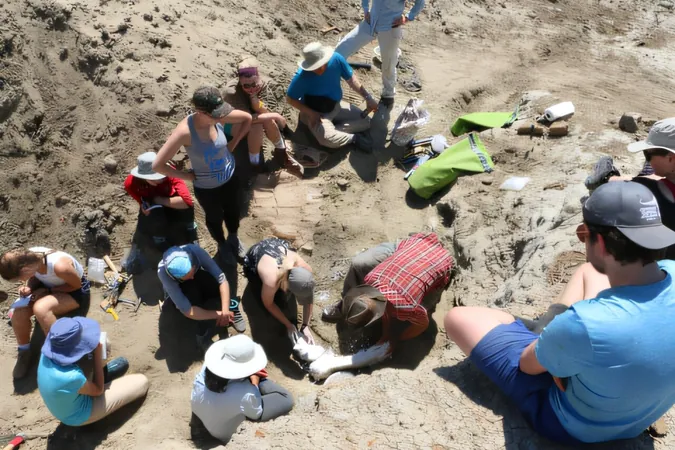
The Light-Saving Secrets of Single-Celled Organisms: Meet Pyrocystis lunula!
2024-11-18
Author: Amelia
The Light-Saving Secrets of Single-Celled Organisms: Meet Pyrocystis lunula!
Have you ever wondered how tiny, single-celled organisms manage to thrive in bright sunlight? It turns out that these microscopic marvels have developed fascinating strategies to protect themselves from an overload of light—just like humans take a siesta or animals seek shelter from the sun. Researchers from the University of Amsterdam have uncovered a remarkable adaptation in a little-known but captivating alga known as Pyrocystis lunula.
Introducing Pyrocystis lunula
Pyrocystis lunula, better known as the luminescent alga, is a dinoflagellate renowned for its stunning ability to create spectacular blue bioluminescence in the ocean. While many of us may overlook its significance, sailors and fishermen have long appreciated its glowing presence in the water. Like plants, this alga harnesses sunlight through chloroplasts to convert light energy into chemical energy. But how does it handle excess light?
Chloroplasts Adaptation
In the plant kingdom, chloroplasts cleverly rearrange to regulate light absorption, minimizing potential damage. However, P. lunula cannot employ this strategy because its chloroplasts are intricately interconnected in a complex network that restricts simple movement. Therefore, researchers were left wondering how this microscopic organism copes with glaring sunlight.
Innovative Study
In an innovative study, biophysicists Nico Schramma, Gloria Casas Canales, and Maziyar Jalaal devised a method to observe the behavior of the chloroplasts under bright light conditions. Using advanced microscopy techniques, they documented how the chloroplasts reacted to varying light intensities. What they discovered was astounding: while the chloroplast cannot escape intense light, it can shrink in size, thereby mitigating the effects of too much brightness.
The Remarkable Adaptability
When exposed to harsh white light, which mimics a sunny day, the chloroplast shrank to a compact ball, reducing its size by approximately 40% in just five minutes. Amazingly, when the light switched to a dimmer red hue, the chloroplast returned to its original size and shape within half an hour. This remarkable adaptability is due to a network of delicate filaments that enable the chloroplast to contract and expand uniformly in all directions— a rare property in nature.
A Hoberman Sphere Analogy
The researchers likened this unique structural ability to a Hoberman sphere, an innovative toy design that expands and contracts as it is manipulated. This connection opens exciting avenues for interdisciplinary exploration, linking biology to mathematics, specifically topology, and materials engineering. Researchers are currently investigating how these biological principles can inspire the creation of 'smart materials' with transformative properties that respond dynamically to external stimuli.
Bridging Biology and Technology
The revelations surrounding P. lunula not only enhance our understanding of this dazzling organism that paints our oceans with bioluminescent light but also bridge the gap between biological structures and advanced material design. The discoveries sparked by this research remind us of the intricate, often hidden solutions found in nature—solutions that can provide invaluable insights for technological advancements.
Conclusion
As we continue to unlock the mysteries of the natural world, it becomes increasingly clear that the answers to fundamental questions can lead to a treasure trove of knowledge across various fields, paving the way for groundbreaking innovations. Who knew that a tiny alga could be such a goldmine for scientific discovery? Keep an eye on Pyrocystis lunula—the secrets it holds might illuminate the path to future technologies.









 Brasil (PT)
Brasil (PT)
 Canada (EN)
Canada (EN)
 Chile (ES)
Chile (ES)
 España (ES)
España (ES)
 France (FR)
France (FR)
 Hong Kong (EN)
Hong Kong (EN)
 Italia (IT)
Italia (IT)
 日本 (JA)
日本 (JA)
 Magyarország (HU)
Magyarország (HU)
 Norge (NO)
Norge (NO)
 Polska (PL)
Polska (PL)
 Schweiz (DE)
Schweiz (DE)
 Singapore (EN)
Singapore (EN)
 Sverige (SV)
Sverige (SV)
 Suomi (FI)
Suomi (FI)
 Türkiye (TR)
Türkiye (TR)